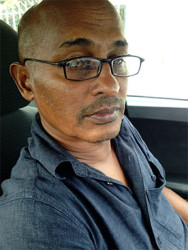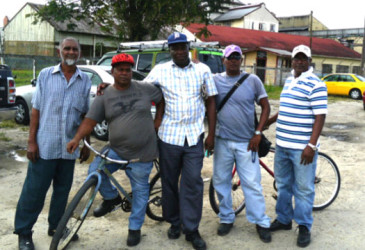…in wake of planned closure
Three weeks after the announcement that the Wales Sugar Estate would be closed later this year, some workers are disappointed that no one from the government has visited to discuss an alternative and they want an independent examination of the condition of the estate.
They told Stabroek News that senior GuySuCo officials are responsible for the planned closure of the estate because they have been giving erroneous information to the government.

The workers questioned why neither President David Granger nor Agriculture Minister, Noel Holder had visited the estate to speak to workers or members of the community before making such a big decision to close the estate. They said that it seemed as though government officials were bent on closing the estate.
“We want to know why they didn’t come… That is gross disregard for the people. Less than a year they’re in office and they’re treating us like that. Don’t they know how to handle or resolve an issue?”
The workers still think they can get the government to reconsider the decision and are asking for “independent people to come and see for themselves that the estate is efficient and can produce a lot.”
According to them, “The government needs to realize that it has a responsibility for the people… They need to save this community. People would go through hardship…”
Workers’ representatives: Sultan Hussain, Gordon Thomas, Mark Khan and others were upset at what they said was the erroneous information being fed from GuySuCo to the government. They cited one official in particular.
They told Stabroek News that “government put him there to do a job fairly but he is not. We want the government to intervene immediately before the situation gets out-of-hand.”
They said too, “If the information he was feeding the government was factual, we wouldn’t fight like this… He would cause the government a serious consequence and the government must be prepared for it.”
Already, 50 workers have lost their jobs after GuySuCo described them as temporary workers. Several others attended meetings with GuySuCo personnel on Monday to know if they would be sent to Uitvlugt, remain at the estate or receive severance benefits or early pension.
The workers vowed that they would not stop protesting until government officials visit the estate and listen to their concerns and launch an investigation into one of the heads.
According to them, the claim that most of the bridges in the fields were dilapidated is false.
They pointed out that one of the excavators that could not cross the Demerara Harbour Bridge because of the weight “crossed the bridges in the estate cultivation to do all the work.” The excavator had gotten across via a “pontoon from the Sandbach koker.”
Khan, a plant foreman, told this newspaper that 11 of the bridges are made of concrete while the others are wooden. “If the wooden bridges are deteriorating, there is a maintenance crew to fix them,” he said.
He pointed out that even though the estate is old as GuySuCo is saying, all of the equipment is being maintained.
He said that another bit of misinformation that is being spread is that 60% of the drainage and irrigation (D&I) is in bad shape, when in fact, “Wales is a gravity flow area” and that “a $200M drainage pump was installed.”
He noted that the estate “has the best irrigation system. We are not short of water here.”
What he could not understand is that the “private cane farmers’ and GuySuCo’s cultivation land run parallel and yet the farmers’ yield is much greater than the estate’s.”
“The estate’s yield dropped to 35% while the farmers’ yield is made up of about 50% of the cane supplied to the factory.”

He is calling for an internal investigation to determine why the estate is falling back on yields.
“I am not denying that the cultivation is in a bad state. In 2002 the estate produced over 30,000 tonnes of cane – that is the capacity. But they need to investigate why it dropped suddenly,” he told this newspaper.
“They need to find out whether poor quality cane, not enough fertilizer, poor tillage or poor supervision” is responsible for the low yield.
“If there is good supervision and collaboration they could produce more cane. They need to check if the supervisors are knowledgeable about cane,” he said.
He insisted that the estate “can achieve 30,000 tonnes of sugar per year easily but we are not getting enough cane. The factory only does recovery; sugar is produced on the fields. That is a point they should focus on…”
He argued too that if the D&I “was so poor, then the estate would not have been able to produce over 20,000 tonnes of cane in 2015. For their information, Wales is not the lowest producing estate.”
According to him, that amount was achieved “even though the estate had almost 400 hours of out-of-cane period.”
In terms of the factory, he said: “90 percent of the pumps are brand new. The evaporators were installed in 1989 along with modern centrifugal baskets [for continuous spinning].”
Khan pointed out too that the estate had acquired “brand new vacuum pans that were never used, three mills and a pol extraction” in the 90s. It also has a “brand new steam turbine to run the crusher and a turbine alternator set.”
He said too that: “all three boilers were recently re-tubed while super heater boxes for boilers have already been purchased. These just have to be installed and we do it ourselves. We don’t have to hire contractors.”
The last thing the workers want is for their efforts to help build the estate to go down the drain and they wished that they “would wake up from this nightmare and hear that Wales would no longer be closed.”
When announcing the closing of the estate, the government had said that Wales is by far the estate in poorest shape.
It then cited the following:-
60% of its D&I infrastructure is run down;
75% of the bridges are in poor shape;
The cultivation is also in poor condition;
The factory is old and in need of major investment.





